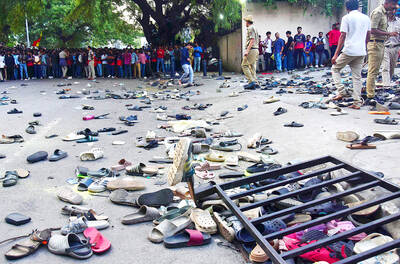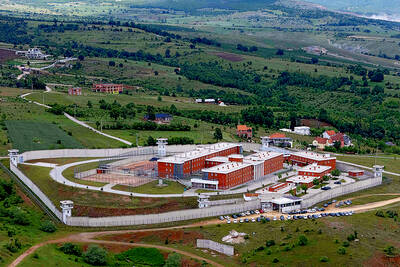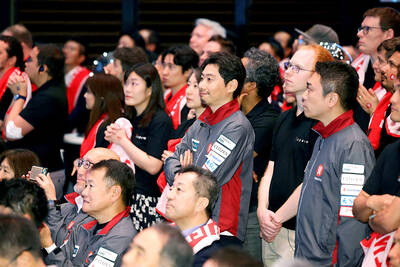Devising a way to one day land astronauts on Mars is a complex problem and NASA scientists think something as simple as a child’s toy design might help solve the problem.
Safely landing a large spacecraft on the Red Planet is just one of many engineering challenges the agency faces as it eyes an ambitious goal of sending humans into deep space later this century.
At NASA’s Langley Research Center in Hampton, Virginia, engineers have been working to develop an inflatable heat shield that looks a lot like a super-sized version of a stacking ring of doughnuts that infants play with.
The engineers believe a lightweight inflatable heat shield could be deployed to slow the craft to enter a Martian atmosphere much thinner than Earth’s.
Such an inflatable heat shield could help a spacecraft reach the high-altitude southern plains of Mars and other areas that would otherwise be inaccessible using existing technology.
The experts said that rockets alone cannot be used to land a large craft on Mars as can be done on the atmosphere-less moon.
Parachutes also would not work for a large spacecraft needed to send humans to Mars, they say.
Hence the inflatable rings.
The rings would be filled with nitrogen and covered with a thermal blanket. Once deployed for landing, the rings would sit atop the spacecraft, somewhat resembling a giant mushroom.
“We try to not use propulsion if we don’t have to,” said Neil Cheatwood, the senior engineer at Langley for advanced entry, descent and landing systems.
“We make use of that atmosphere as much as we can, because it means we don’t have to carry all that fuel with us,” he added.
NASA’s leaders acknowledge that getting humans safely to and from Mars as early as the 2030s poses extreme challenges.
The agency’s scientists acknowledge they must also design new in-space propulsion systems, advanced spacesuits, long-term living habitats aboard spacecraft — even communication systems for deep space.
Work is proceeding, sometimes fitfully.
When an unmanned private rocket destined for the International Space Station exploded in October soon after liftoff from Wallops Island, Virginia, numerous scientific experiments went up in flames with it.
However, one NASA experiment that Orbital Sciences Corp originally invited aboard — for a second-generation inflatable spacecraft — never made it for lack of time to get it together, NASA officials say.
That experiment calls for testing how second-generation inflatable spacecraft technology performs upon re-entry in Earth’s atmosphere.
The test is important because NASA officials believe an inflatable heat shield could be what helps them land astronauts on Mars and return larger loads of supplies from the International Space Station. The experiment is now scheduled to go up on the next Antares rocket next year.
New technology is needed to get astronauts to Mars because the type of spacecraft that would land humans would be much larger than anything that has landed on the planet previously.
Current heat shield technology weighs too much to be on larger spacecraft, which means scientists cannot land anything much larger than the rovers that have been sent there previously.
NASA has relied on parachute-based deceleration on Mars since the Viking program in the 1970s.
Engineers at Langley have been working on the inflatable technology for about a decade and believe it is close to being ready for operational use.
“If I had the budget and we had the funding to do it, I think we could get as large a scale as needed for humans in five to 10 years,” Cheatwood said.
He said the same inflatable technology could also be used for spacecraft to explore other planets or objects with atmospheres, such as Venus, Jupiter and Titan, Saturn’s largest moon.
As the inflatables are made of lightweight material and filled with nitrogen, more room is left aboard a spacecraft for science experiments and other things that astronauts need.
The inflatable is covered by a thermal blanket of layers of heat-resistant materials.
“The idea is that you would have something that could be packed up, put in a very small volume and then deployed into a very large size,” said Anthony Calomino, principal investigator for materials and structures for hypersonic re-entry at Langley.
He said in a statement in April: “Think airbag, something we could pack into compressed volume that will fit the size limits of a launch shroud, but allow for a much larger aeroshell.”
Smaller scale, inflatable experiments have been launched on rockets before, but never into orbit. That work was recently part of a NASA review in October.
The information gathered from those earlier projects is set to be applied to the upcoming, larger-scale experiment next year.
It still will not be large enough to protect a spacecraft carrying astronauts, but NASA scientists believe the technology is sound.
“When you first tell people you’re going to do an ... inflatable spacecraft, they have in their minds something really floppy like a jellyfish and it’s really not that way,” Cheatwood said.
“They are very durable ... This is a technology that I think is ready to use, whether it is for humans in 20 years on Mars, or whether it is a large robotic mission sooner than that,” he said.

Packed crowds in India celebrating their cricket team’s victory ended in a deadly stampede on Wednesday, with 11 mainly young fans crushed to death, the local state’s chief minister said. Joyous cricket fans had come out to celebrate and welcome home their heroes, Royal Challengers Bengaluru, after they beat Punjab Kings in a roller-coaster Indian Premier League (IPL) cricket final on Tuesday night. However, the euphoria of the vast crowds in the southern tech city of Bengaluru ended in disaster, with Indian Prime Minister Narendra calling it “absolutely heartrending.” Karnataka Chief Minister Siddaramaiah said most of the deceased are young, with 11 dead

By 2027, Denmark would relocate its foreign convicts to a prison in Kosovo under a 200-million-euro (US$228.6 million) agreement that has raised concerns among non-governmental organizations (NGOs) and residents, but which could serve as a model for the rest of the EU. The agreement, reached in 2022 and ratified by Kosovar lawmakers last year, provides for the reception of up to 300 foreign prisoners sentenced in Denmark. They must not have been convicted of terrorism or war crimes, or have a mental condition or terminal disease. Once their sentence is completed in Kosovan, they would be deported to their home country. In

Brazil, the world’s largest Roman Catholic country, saw its Catholic population decline further in 2022, while evangelical Christians and those with no religion continued to rise, census data released on Friday by the Brazilian Institute of Geography and Statistics (IBGE) showed. The census indicated that Brazil had 100.2 million Roman Catholics in 2022, accounting for 56.7 percent of the population, down from 65.1 percent or 105.4 million recorded in the 2010 census. Meanwhile, the share of evangelical Christians rose to 26.9 percent last year, up from 21.6 percent in 2010, adding 12 million followers to reach 47.4 million — the highest figure

LOST CONTACT: The mission carried payloads from Japan, the US and Taiwan’s National Central University, including a deep space radiation probe, ispace said Japanese company ispace said its uncrewed moon lander likely crashed onto the moon’s surface during its lunar touchdown attempt yesterday, marking another failure two years after its unsuccessful inaugural mission. Tokyo-based ispace had hoped to join US firms Intuitive Machines and Firefly Aerospace as companies that have accomplished commercial landings amid a global race for the moon, which includes state-run missions from China and India. A successful mission would have made ispace the first company outside the US to achieve a moon landing. Resilience, ispace’s second lunar lander, could not decelerate fast enough as it approached the moon, and the company has